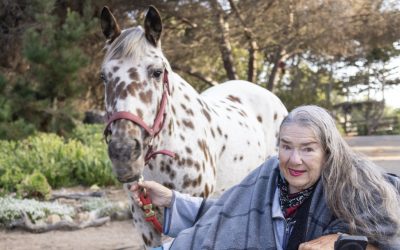Under the radar for years, fostered youth students now find new help—and hope
Most of us cannot comprehend how it would feel, in high school, to sit in an assembly presentation about the benefits of attending college and think, “What am I doing here? They’re not talking about me.” That the person speaking was not speaking to you. That you were the odd person out because you were a fostered youth living a disparate lifestyle than most of the people you went to school with.
And, even if you did somehow find a way to graduate from high school—in spite of multiple moves, a traumatic childhood, subsequent separation from your family and being transferred to multiple schools—how do you make your way to be accepted to and finish college?
Imagine, then, a caring counselor tells you, “You CAN do this, and I can help you.” Thanks to California bill AB854 and programs through the County Office of Education, The County of San Luis Obispo and the services of Lisa Allardyce along with a team of community partners, there’s been an uptick in the dreams of young people—fostered and post-fostered making their way through the educational system—coming true.
THIS TWO-PART ARTICLE WILL FOCUS ON THE FOSTER youth in our county and their journeys through a system that is developing a more favorable approach—thanks in part to a state sponsored school finance reform plan—to reducing their struggles regarding the educational system that for many years has been a far reach for them to complete.
The odds are against many of these children from early on. A fostered child may experience difficulties across a broad spectrum of life—health, forming relationships and educational advancement among them. Historically, until passage of AB854 in 2015, California had little statewide information about the education of fostered school-aged children and youth in the system, the educational needs of these students have gone unrecognized and unmet, according to Vanessa Barrett and Bethann Berliner, authors of “The Invisible Achievement Gap: Education Outcomes of Students in Foster Care in California’s Public Schools.” Data gathered reveals, “California students in foster care have unique characteristics that justify their identification as a separate at-risk student subgroup that has a significant achievement gap compared to other student groups.” (This report is described as a first-ever education snapshot of all K – 12 students in foster care in the state.)
Those “unique characteristics” identified with the fostering experience by the study show that the students in foster care were more likely to be classified as low SES (socio-economic status); they were three times more likely to be African American, twice as likely to be a student with a disability and five times more likely to be classified with an emotional disturbance. They were also older in age for their grade level: a likely outcome of grade retention and a risk factor for dropping out.
In 2010, there were nearly six million K-12 students enrolled in California schools according to that year’s census data. Among those, nearly 44,000 were children who had spent a period of time in child welfare-supervised foster care that year—about 1 in every 150 students. Of particular interest is current data that reveals statewide, foster students have a high school graduation rate of just 58 per cent—the lowest rate among at-risk student groups.
Findings describe some eye-opening information about fostered youth students as a subgroup:
• As discussed above, they constitute an at-risk subgroup distinct from low-SES students
• They are more likely to change schools during a school year
• They are more likely to be enrolled in the lowest-performing schools
• They have the lowest participation rate in California’s statewide testing program
• They show an achievement gap in proficiency in core subjects, particularly English language arts and mathematics, and
• As high school students have the highest dropout rate and lowest graduation rate
In light of less-than-encouraging data, there is hope, forward momentum and hard-won success as Lisa Allardyce, Choice Educational Services, and Jessica Thomas, Program Coordinator, Student Programs and Services, SLO County Office of Education, describe local efforts to see young foster students through high school and college, one by one.
Both women acknowledged at the start of the interview their accomplishments since 2012 are a result of a wide net of teamwork saying, “Our success is due to the collaboration and generosity of this community.” Indeed, they credit the County of SLO Department of Social Services Department Child Welfare Services, Family Care Network, SLO County Office of Education Homeless and Foster Youth Services along with all SLO county high school counselors, all district liaisons, CASA’s mentors, resource parents and caregivers, ILP Coordinator and case managers, social workers and therapists and teachers as valuable partners.
But Thomas hands off the majority of credit to Allardyce, an independent contractor who found her calling by kismet. Searching for “something more” after leaving her position as a college-counseling specialist at Mission College Preparatory High School, a stop at a local Starbucks proved opportune. “I ran into an acquaintance there who worked at the County and we talked about her efforts with new mandates to increase educational success rates of at-risk students and she mentioned she could use some help,” Allardyce said. “I said, ‘I’d love to help,’ and from that conversation things just unfolded.”
Allardyce started her own business, Choice Educational Services, with a vision of “Empowering students to reach toward their highest potential” by “Empowering, Guiding and Mentoring current and former foster youth on the educational pathway.” Out the gate, she said she already knew of a handful of students who could use her services so “I got to work right away,” she said. She also started meeting with other agencies and promoting her services to assist in their compliance with AB854 and increasing high school graduation rates and college enrollment rates in the foster student population.
At one college awareness function, Allardyce met Jessica Thomas who was involved with foster students’ progress through the County Office of Education and after talking for a bit; they realized their visions were aligned. One of the biggest problems for an agency worker, said Thomas, is that the kids often need help “after hours or on weekends.” With Allardyce’s services, the program had a better chance of access and thereby, success. “Whenever she sees a need, she fills it,” said Thomas of Allardyce. Currently, Allardyce contracts with both the County of San Luis Obispo and the SLO County Office of Education to offer services that meet those agencies’ criteria for foster youth student success. Allardyce said while she typically works “wherever she needs to be,” Cuesta College has designated a shared office space for her work with her student clients there, recognizing the importance of her work assisting students who are working towards their associate’s degree and potentially moving on to a four-year curriculum.
Speaking with Allardyce, it’s obvious her commitment to students is 100 per cent. “If a student needs to be driven to Humboldt to check out a college, off we go,” she said. “If they need help with college entrance essays, if they need someone to be there with them on move-in day, I’m here to help them,” she said. “What many of us take for granted—filling out forms, having our family drive us to our dorm—could be difficult for these students to manage. If I can get them through that, they have a better chance to gain confidence and embrace their college experience.”
But Allardyce comes back again and again to the importance of community involvement. “I see myself as a dot connector,” she said. “I meet with people all the time from so many other agencies and programs and my network is incredible. We’re all here to work together to get these kids through school and life and achieve success. “We have presented to other foster youth services and share our successes,” she said. “Jessica and I have worked together on data and we talk with counseling teams about homeless and foster youth education code and education related resources.”
“So far, I’ve worked with foster and former foster students aged 14–24 and have had some amazing success stories,” Allardyce said. “If they believe they can go to college, if they get the grades and put forth the effort, they find they can do it. Our county has one of the highest high school graduation rates for this population in the state, which is my number one goal.” The data indicates that in 2017-2018 school year, there were 43 high school seniors in foster care in SLO county schools with a 74.5 per cent graduation rate, far above the statewide rate.
Allardyce said her motivation and her love of this work is what she was always looking for. “I’ve always been service-oriented but my background was in business,” she said. “I just always felt I needed the ‘heart piece.’” Having found it, she said, “Human beings, especially children and young adults when given the opportunity, support, and love have the ability to a make lasting impact and changes in their own lives. These remarkable students inspire each other and those that work with them. Together we heal our children, our young adults, our communities, and most importantly ourselves.”
In Part 2, read about real-life success stories, the on-going challenges and opportunities for foster students, and how someone considering becoming a foster parent might want to learn about the “rewards” side of seeing a young person thrive and perhaps become part of that process.





